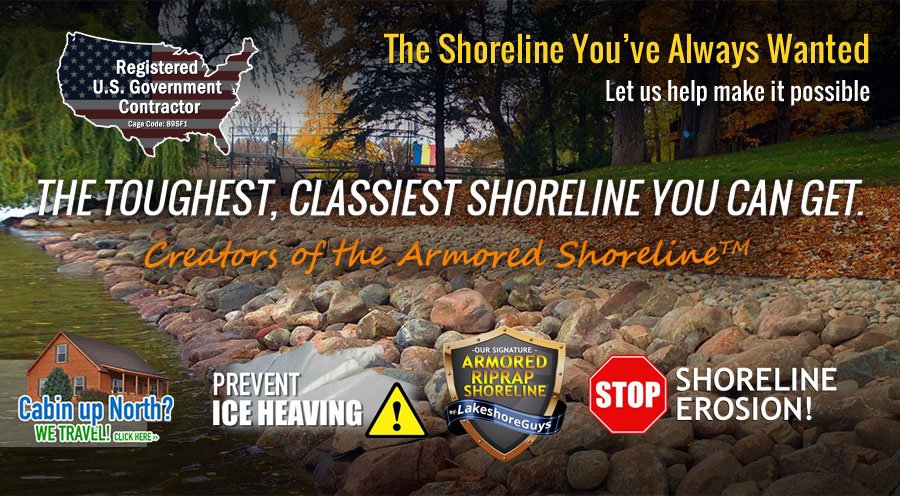Should You Get Your Shoreline Riprapped in Winter?
Some shoreline companies and nearly all landscapers (both looking for winter cash flow) sell their customers on the idea that the best time to get a shoreline riprapped is during the winter. The idea is they won’t have to drive through the grass and ruin your yard, or perhaps there’s a steep slope down to your shoreline that prevents the use of equipment. Instead they convince their ill-informed clients that they can just drive the dump truck and equipment over the frozen lake instead. It “sounds” great!

18 years ago or so, we would have agreed. Then we got wiser and started understanding our job better.
Knowing what we know, we would never riprap a shoreline in winter.
(We can only think of one possible exception, in which the customer lived on an island and a barge was not available to transport material and equipment to the shoreline. But even then we’d visit the shoreline in the late fall and to do some sloping and grading work by hand before we started the riprap job in the winter. Achieving the proper slope is the single most important step when riprapping a shoreline – and frozen soil cannot be graded.)
The “riprap in winter” folly was borne of landscaping companies’ need for cash in the winter. It’s yet another reason you should never hire a landscaping company to restore your shoreline. They assume you know even less about shorelines than they do.
Riprapping a shoreline in the winter prevents us from sloping the shoreline properly, securing the fabric to the ground with staples, and making sure the riprap is properly placed on the fabric once the ice has melted.
Hey, our shoreline-restoration work is slow in the winter, too. We like offseason cash, too. But we’d much rather work on your shoreline at the right time of year, so that it lasts, and so we have you as a customer who maybe even tells a shoreline-owning friend or two.
The two most important parts of riprap are the grade and the fabric.
You can’t grade the land correctly during the winter.
Of the two key factors – high quality fabric and grade – grade is the even-more-important part of successful riprapping. Whenever possible, you need a proper 3:1 grade (or lower) to have any chance at preventing an ice ridge from forming, due to ice jacking during the winter months or wind-driven ice in the spring. The same can be said for preventing erosion- a 3:1 slope is ideal.
How can you re-grade the shoreline during winter? You can’t. All you can do is throw down some fabric and spread some rock over it, which is not a proper riprapping job. There’s also no way to staple the fabric in place, so you have no idea what’s going to happen to your new shoreline when the ice melts.

You can’t place the fabric correctly during the winter.
When you’re riprapping a shoreline it’s vital to have extra fabric on both the landward and lakeward side of the shore.
We can’t think of a way to do that in the winter. We suppose you could leave 4 feet of extra fabric on the ice, but as the riprap starts to melt and break through the ice it will just roll into the lake. There’s no telling where the riprap will end up.
Dirty riprap during the winter.
We go through painstaking measures to keep shiny new fabric free from as much dirt as humanly possible. Dirt atop your fabric equates to weed growth! If you don’t want your shoreline to look like a Chia Pet in short of a year or two, keeping the riprap as dirt-free as possible is the key. All riprap has plenty of dirt mixed in with it, even screened & sorted riprap. Having riprap delivered in the winter months means that any dirt within the riprap is “frozen” to each individual stone. For this reason it’s impossible to separate the dirt from the riprap via a ribbed riprap bucket. We’re also unable to flush the riprap with high volumes of lake-water (flushing any of the finer particles of dirt free from the riprap & fabric. You can see the large amounts of dirt frozen on the riprap within the photo above (no…that’s not brown snow, it’s dirt!).
We’d love to make extra cash during the winter, too, but….
Fortunately for your shoreline and your wallet, we aren’t willing to cut corners just to make a few extra bucks in the offseason. Rather, we have other ways to protect your yard from damage. In fact, we’ve worked out a method of using older, low-tread floatation tracks on our frontend loader after we realized we could not, in good conscience, continue to riprap shorelines in winter. Using such low-tread floatation tracks will almost always spare your yard the destruction caused by most other tired and metal-tracked equipment that almost all other companies use.
If we can’t access your shoreline with our equipment, then we’ll use wheelbarrows or a construction chute. If for some reason you require a riprap shoreline, we will figure out a way to access your shoreline with equipment and/or riprap without having to rely on Old Man Winter, and we won’t destroy your yard in the process. Should your yard sustain “some” damage, we’ll repair like a par 3 on Pebble Beach.
So we’d be thrilled if you call us, but we hope you call us during the spring, summer, or fall – when we can do the job correctly and once.



